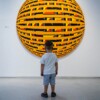Arnold’s Influence on Hartshorne
In his intellectual autobiography, titled The Darkness and the Light (a title that is an allusion to a famous line from William Wordsworth’s poem “The Simplon Pass”), Hartshorne tells us that he grew up in a religious household; his father was an Episcopal minister. The seeds of his difficulties with orthodox Christianity were sown when he read some essays by Ralph Waldo Emerson when he was fifteen or sixteen, but these difficulties became more prominent and led to something of an existential crisis in his sixteenth year when he read Arnold’s Literature and Dogma. The turmoil created by reading Arnold is evidenced in Hartshorne’s admission that, as a result of reading this book, for a few months he abandoned his belief in a God of love, the only time in his (very long!) life when religious skepticism took hold of him. Another indication of the momentous character of his reception of Arnold’s ideas is that, when he expressed his religious doubts to his mother, she cried. This was the only time he ever saw his mother weep.1 No doubt part of the story here is that at sixteen Hartshorne had reached the developmental point at which one is apt to challenge received views so as to establish one’s own identity.
Hartshorne’s father was in many respects an orthodox Christian whose religious belief was centered on the miraculous resurrection of Jesus. However, he was nonetheless an enlightened believer who was not shocked by his son’s adolescent religious skepticism. In fact, Hartshorne got the copy of Arnold’s book from his father’s collection. Hartshorne’s father actually liked to read Arnold and was known to include references to Arnold in his sermons. Father and son corresponded for several years in most friendly terms on many important topics, especially religious ones. Later Hartshorne would converse in equally friendly terms with his father-in-law about Arnold’s ideas.[ii]
Whereas Emerson’s attacks on conventional Christianity seemed veiled and did not really register with the young Hartshorne, Arnold’s attacks were seen as clear-cut and caused an “explosion” in Hartshorne’s mind. His theoretical options seemed to have been to: (1) drop all religious beliefs; or (2) become a philosopher so as to rethink theism in light of Arnold’s criticisms. Hartshorne eventually became famous as a result of his choosing the second option. He never took seriously a third option proposed by Arnold, a position that Hartshorne saw as a “desiccated formula”: God is the enduring power, not ourselves, that makes for righteousness. That is, until Hartshorne found a viable philosophical concept of God that involved more than a source of inspiration for our moral lives (worthy as this goal is) and that could replace the concept of God found in conventional Christianity, he was “between two worlds”: one dead and the other not yet born.3 This admission prepares us well for the in-between status of Hartshorne’s view, to be discussed below.
It was Arnold who shook Hartshorne out of his “dogmatic slumber” such that any future religious belief he was to hold had to be philosophical and rationally defensible. Between attendance at Haverford College and Harvard, Hartshorne worked as a medic near the front line in World War One. This latter experience reinforced his Arnold-induced conviction that we are not well served by thinking that miracles will save us. Nonetheless, Hartshorne not only returned to theism a few months after reading Arnold, he remained steadfast for the remainder of his life in the conviction that Deus est caritas: God is love. This conviction, he thought, was very much compatible with the two great commandments of the Christian scriptures: love of God and love of neighbor that is comparable to love of self. These commands, he thought, were compatible with most of the major religions in the world, so there was nothing narrowly sectarian in his conviction.[iv]
Miracles as Outmoded
The most significant feature of Arnold’s Literature and Dogma5 is his trenchant critique of a version of Christianity based on miracles, which Arnold saw as “the phantasmagories of … prodigal and wild imaginations.” He realized that for many religious believers, miracles proved theism to be true, specifically a version of theism characterized by a grandeur that inspires awe and admiration. Further, miracles are alleged to prove the existence of God as omnipotent. But Arnold thinks that no such “proof” works (VI. 211, 233). In this connection it is worthwhile noting the title of one of Hartshorne’s own works: Omnipotence and Other Theological Mistakes.[vi]
In order for Christianity to endure, Arnold thinks, it has to rely on something other than miracles; it would have to be seen as valuable independently of miracles. Just as the miraculous stories related by Herodotus and Plutarch have come to be seen as incredible, Arnold thinks that the same incredulity is occurring with respect to miraculous stories in the Bible. What rational person can continue to believe that the Red Sea really opened a passage for the Israelites in particular or that the walls of Jericho miraculously fell down at the sound of a trumpet? The message of Jesus, too, can endure only if it is stripped of its miraculous trappings, he thinks. In short, belief in miracles was due to want of experience in human beings, to ignorance, and to a sense of helplessness in the face of life’s difficulties (VI. 248-249) .
The Bible will be more and more thrown aside if it is not demythologized, according to Arnold. (Arnold does not use the word “demythologized,” but it is clear that he prefigures Rudolph Bultmann in his understanding of this concept.7) Once it is demythologized, he thinks, people will be drawn to the Bible with a new zest, as if by a fresh spell. The Bible can again come to be seen as a pearl of great price (VI. 250, 253; also see Matthew 13:45-46).
This theme regarding the outmoded character of miracles is found in several other works of Arnold in addition to Literature and Dogma. He notes that, for the unfortunate multitude, religion seems imposing only when it is subversive of reason and as confirmed by miracles. Further, religion takes hold of most people only when it is seen as infallible and holds out the prospect of eternal damnation for those who do not obey. So also Hartshorne denies personal immortality and a system of rewards and punishments in the afterlife.[viii] If miracles are violations of laws of nature, it is easy to understand why reason dictates that they are impossible. But this rational perspective need not be non-theistic if the laws of nature themselves are seen as divinely created. For God to violate the laws of nature would be to contradict divinity itself, on Arnold’s view (III. 168).
Arnold was like Spinoza in seeing miracles as impossible.[ix] He admires in Spinoza a critique of miracles that is entirely devoid of Voltaire’s passion for mockery (see Voltaire’s “On the Interpretation of the Old Testament” and “On the Interpretation of the New Testament”[x]) and David Strauss’s passion for demolition.[xi] Miracles are, quite simply, not believable (III. 172-173, 179). Arnold admits that he has no argument against miracles as found explicitly, say, in David Hume and Immanuel Kant. Miracles have simply become irrelevant and, as the title to this section indicates, outmoded or doomed. Rational human beings slowly but inevitably put them aside. That is, Arnold’s approach is not as critical as the view of those who think that they have rationally demonstrated the impossibility of miracles. But Arnold does put belief in miracles on a par with belief in hobgoblins. Arnold’s critique of miracles is part of a more general effort to elevate religious discourse to a level where it belongs, as in the effort to understand the real meaning of Christmas in terms of the presence of undeserved love for us and of undeserved gifts we have received, in contrast to fantastic stories regarding the virgin birth of a God-man. In this regard Arnold’s views are somewhat similar to those of John Stuart Mill, who concedes that if God exists then miracles are at least possible, but this is a far cry from an actual defense of miracles. Further, Mill thinks that utilitarianism is the best way to understand morality; hence whatever value religion has cannot triumph over the utilitarian calculus. But Mill’s view is similar to Arnold’s and Hartshorne’s in that all three thinkers see God as all-good yet not all-powerful (VII. 164-166; VIII. 406; X. 218-219, 231). [xii]
The Role of St. Paul
Arnold’s critique of miracles in Literature and Dogma, which profoundly affected Hartshorne, is focused on the writings of Paul, whose own conversion is itself depicted as miraculous. But one can profit from a consideration of his conversion without the miraculous element, just as Jesus’s “resurrection” can be magisterial without its being miraculous, as Arnold sees things. Paul helps us to realize that resurrection is essentially a sense of rising from a morally repugnant life to one that is upright and has integrity. Of course Paul himself saw Jesus’s resurrection as miraculous, but his own assessment of this phenomenon is not necessarily the best guide to its value for us and for religious belief in general, on Arnold’s view. Or better, despite his own belief in miracles, Paul is especially instructive in his incessant effort to find the moral significance of these occurrences (VI. 34, 50-52, 54, 71).
It is not Jesus himself who relates his own (alleged) miracles to us, a fact that is perhaps disconcerting to those who see him primarily as a thaumaturgist (that is, a miracle worker). In fact, Jesus is reported to have complained about those who believed solely or primarily on the basis of “signs and wonders” (see John 4:28; 14: 11). It seemed that a whole generation required such signs (Mark 8:12) and could not understand any message other than the most literal one conveyed in infantile terms, on Arnold’s view. Miracles contributed outward evidence concern- ing that which Jesus thought could only be adequately understood on the basis of inward evidence accessed through conscience. Paul, despite his own belief in miracles, understood well the importance of being seized by the inwardness of Jesus’s message (VI. 258-259, 261-265, 269-271).
Another way to put the point is to say that the evidence from (supposed) miracles is superseded. Arnold thinks that Paul’s writings are eminently worthy of our attention even if Paul himself was an ardent believer in miracles. Paul is interesting, on Arnold’s interpretation, precisely because he simultaneously holds out the temptation to found Christendom on the most facile and reprehensible credulity, on the one hand, and he points the way toward a symbolic and ethical view of religion, on the other (VI. 273, 318, 344; VIII. 112-113).
Protestant and Catholic
Arnold’s critique of miracles has implications for some very particular approaches to religion that are influential, especially those that he identifies as Protestant and Catholic. In both cases the spirit of the modern age militates against the miracles found in these approaches. As human experience widens, belief in miracles becomes attenuated. Protestants think, Arnold claims, that the biblical miracles form a class by themselves that are immune from criticism, whereas Catholics think that the biblical miracles as well as those found in their own church are so immune. In the latter case, each Catholic Mass involves the miracle of transubstantiation that occurs on a daily basis. What unites traditional versions of both approaches is belief in the miracle of Jesus’s atoning sacrifice. It should be emphasized that Arnold does not think, as some religious skeptics do, that this atoning sacrifice is degrading superstition. It is Jesus’s sacrifice seen as a miracle that is problematic, he thinks, not the very notions of atonement or sacrifice. This is analogous to Arnold’s idea that it is not so much scripture itself that is problematic as a literal and unintelligent reading of it (VI. 246-247, 353, 358-359).
Which of these two traditions will be more likely to join the modern spirit and its distrust of miracles? Arnold thinks that Protestantism is more likely to progress in this regard, given Catholicism’s nineteenth-century clash with modernism and its tendency to retreat into Marian “miracle mongering.” But the grand style and actual practice of Catholicism, he notices, might enable it to better adapt to the modern world once it begins the process of slow adaptation (III. 97). One is here reminded of Aesop’s fable of the hare and the tortoise. Likewise, despite several strong criticisms of Catholicism on Hartshorne’s part, he (like Alfred North White- head) thinks that one of the defects in the Protestant reformers is that they did not reform the classical concept of God. Hartshorne’s own neoclassical concept of God, by way of partial contrast, ironically relies almost as much on St. Thomas Aquinas as it does on Whitehead.[xiii] That is, Hartshorne’s concept of God is “neo” as well as “classical,” as we will see.
Or again, Arnold thinks that the children of present-day Protestant parents will lose belief in miracles, whereas it will be the grandchildren of present-day Catholic parents who will achieve this result. Both religious tendencies still have room to fulfill their intellectual potentials, but the greater willingness in Catholics to admit new miraculous data makes the project a bit more difficult, although the greater weight of the intellectual past of Catholicism also ironically makes it more likely than in Protestantism to be eventually delivered from miracles. In both cases, however, the worldwide influence of Christianity, although it may appear to be due to the force of its miracles, is more likely explained in terms of the moral and psychological appeal of Jesus. We will see that the future of Christianity lies, Arnold thinks, in such appeal (VII. 369, 389-391; III. 97; V. 172-173).
At times Arnold seems to indicate that one example of a miracle in traditional religion is belief in God as personal, although later we will see that there are metaphysical reasons in Hartshorne for defending belief in God as personal that do not depend on a miraculous basis. When Arnold speaks in this way he is criticizing the Pauline notion of God as a magnified and non-material human who animates not this or that body, but the body of the entire cosmos, which strikes Arnold (but not Hartshorne) as miraculous (VII. 163, 172).
Contra Metaphysics
It would be a mistake to think that Arnold’s critique of traditional theism (which Hartshorne calls classical theism) involves a movement toward a more intellectualized version of theism found in metaphysical argumentation. In fact, he thinks in Literature and Dogma that turning religion into metaphysics weakens it because metaphysical arguments lack the power to lay hold of people. God is not so much a metaphysical concept as a moral feeling we have, he holds. Abstruse reasoning regarding the necessary existence of God or an argument in favor of a Designer for nature are the learned versions of theism that are on a par with the stupendous miracles of popular religion. This is because they fail to convince, on Arnold’s view (VI. 241-245, 452).
“Reasons” drawn from miracles and reasons drawn from metaphysics are similar, he thinks. This claim is ironic due to the fairy-tale quality of the former. It is the fact that neither sort of reason really convinces intelligent people, neither “gives rest” to troubled souls, and neither produces joy, that impresses Arnold. Further, any attractiveness to metaphysical religion came historically from the nourishment and support it received from miraculous religion. Propositions regarding essence and existence have no staying power of their own apart from the backdrop provided by miracles, he thinks. God seen as a magnified and non-natural human being (historically a man) is equally the unpersuasive result of miracle-based and metaphysical thinking. The “science” of metaphysics, he holds, consists in formal intricacies of thought intended to make intelligible the miracles that would otherwise be quite unintelligible. Miracles did not happen and metaphysics is mere words. Christianity has a future, as Arnold sees things, only if it is based on the natural truth of humanity’s Christlike moral worth (VII. 198-200, 205, 387; VIII. 153).
The Future of Religion
Although Arnold thinks that the future of religion is to be found in a region beyond both miracles and metaphysics, it is not beyond the Bible. Rather, understanding the Bible is not only gradual but also progressive. In fact, it contains truths as yet undiscovered in the sense that thoughtful readers are still in the process of tracing vague hints in difficult passages. Christianity has a “natural truth,” which suggests that imitation of Jesus is actually religiously superior to belief in a miraculous incarnation of God into human history. As before, “miracles do not happen” (VI. 146, also 142-143). It is only when it is assumed that Christianity is based on miracles that it makes sense to think that it is a cheat or an imposture. Once that assumption is left behind, the whole terrain looks much more natural and believable and compatible with a contemporary worldview (VI. 236-237, also 87).
Although the gospel writers themselves, along with Paul, saw thaumaturgy in everything that Jesus did, this does not mean that we have to do the same. For example, we could, by way of partial contrast, concentrate on the “moral therapeutics” of Jesus’s message, both literally (given Jesus’s apparent belief that much physical disease is at root moral or spiritual) and symbolically. Christianity need not be lost along with its miracles. Unfortunately, there is something addictive to belief in miracles, much like addiction to opium, Arnold notes. The very thought of turning away from the drugs in question often triggers a convulsive reaction, a passionate resolve to hold on to what is slipping away in religion by appealing to authority, in particular (VI. 255, 257, 379).
In all of the Abrahamic religions there is both a tendency toward miracle and the possibility of a more fruitful approach wherein the intrinsic correspondence with the urgent needs of human nature is encouraged. With growth in such correspondence comes commonality among the Abrahamic religions, in particular, and among all of the world’s great religions, in general. Divisive creeds and mutual anathemas might very well become obsolete, Arnold hopes. In short, there would be less of a need for all of the negative things for which religion has become infamous. A preoccupation with miracles not only warps our understanding of Jesus, it also makes it less likely that there will be rapprochement with admirable persons in other religious traditions. This is a pity, given the boundless consolation to be found in the discourse Jesus can inspire. Arnold is encouraging us finally to get serious about Jesus’s moral message (VII. 35, 143-144, 170, 367-368, 370, 385, 394).
In sum, Arnold hopes for a religion that will be a national society for the promotion of goodness, an eventuality that would be due to an intellectual revolt (or at least a gradual transformation) against both miracles and metaphysics (VIII. 130, 146, 149). We will see that Hartshorne does not share Arnold’s distrust of metaphysics, although this does not mean that there cannot be rapprochement between the two. In fact, Hartshorne’s metaphysics dovetails with Arnold’s hope for the future of religion in that his life’s work was to develop a metaphysical scheme that could help us to better understand the claim that God is love, a claim that is very much compatible with Arnold’s ethicized religion. The strictly permanent, Unmoved Mover of classical theism makes the concept of divine love unintelligible. If X loves Y, and if Y starts to suffer (with X standing for God and Y standing for a particular creature), then what sense does it make to say that X as omnibenevolent remains strictly unmoved?
The Mature Hartshorne
In this long final section I would like to explore the extent to which the work of the mature Hartshorne shows Arnoldian traces and also shows significant differences from Arnold. In this regard I would like to make three points. First, I will claim that Arnold and Hartshorne share an in-between status that is alluded to in the title of the present article. This similarity, I think, overshadows the two significant differences between the two: second, I will show how Hartshorne’s own approach to miracles is somewhat different from Arnold’s; and third, his approach to metaphysics is very much different from Arnold’s disdain for this discipline. Nonetheless, the fact that each of them theorized in between two analogous sorts of opposition means that Hartshorne never quite got over the early influence of Arnold on his thought.
Regarding the first point, it has been claimed that religion was the constant preoccupation and true center of Arnold’s whole life (see the online Encyclopedia Britannica entry on Arnold). Likewise, Hartshorne’s thought was theocentric; in this regard he was almost alone among major philosophers in the mid-decades of the twentieth century. As one of the founders of Anglican modernism, Arnold was like most religious liberals in coming under attack from two sides, hence his in-between status: from the orthodox, who accused him of infidelity, and from religious skeptics, who despised the fact that he clung to Christian beliefs. Arnold even clung to the church, despite the fact that he had taken away the apparent foundation for this institution based on miracles. Likewise, Hartshorne, who is usually labelled as a process theist, preferred the label “neoclassical” theist, hence his in-between status. Traditional theists scorned him because of the “neo” elements in his thought and agnostics and atheists had little patience for the “classical” elements in his defense of theistic belief. Here Hartshorne continues an in-between tradition within process theism itself that includes Whitehead and Henri Bergson. For example, when Whitehead started talking about God in his later philosophical works when he went to Harvard, after a long career in England as a famous mathematician and philosopher of science, he elicited the same bifurcated response. Some of Whitehead’s friends who were traditional theists were scandalized by his innovation, whereas some of his friends in the sciences who were religious skeptics were equally scandalized, but for different reasons.
Second, although Arnold’s critique of miracles had a decisive effect on Hartshorne, the latter’s mature philosophy is not identical to Arnold’s on this topic. Hartshorne no doubt agreed with Arnold that any religion that is based on miracles rather than on what is reasonable to believe is childish and not worthy of our assent. The fact that miracles do not play any significant role in Hartshorne’s philosophy is evidenced by the fact that he treats miracles only twice at paragraph length. Because Hartshorne wrote a whole library shelf of books dealing with the concept of God, this paucity of attention to miracles itself speaks volumes.
In one of the paragraphs in question (found in Hartshorne’s 1984 work Om- nipotence and Other Theological Mistakes), Hartshorne actually takes an agnostic approach to miracles. Although he does not defend belief in miracles, he also is reluctant to restrict divine agency to natural laws as we know them. Hartshorne is not here opening up the possibility of divine supernatural intervention into the natural world. It is primarily the bifurcation between this natural world and that supernatural one that Hartshorne and Whitehead are reacting against in their different versions of process theism. Rather, although God is not omnipotent in Hartshorne (for various reasons), God as the greatest conceivable being nonetheless possesses maximal or unsurpassable power and wisdom. Hartshorne thinks it crucial to leave open the possibility that such a being could, and would know how to do so wisely, influence the course of events for the better by stretching natural order beyond what is at present within our ken.
The issue that is being discussed here can only be understood against the background of process theodicy. Creaturely freedom itself is a good thing, Hartshorne argues, but with such freedom comes risk: “the opportunities involved in a given degree of freedom tend to increase only with a corresponding increase in risks.”14 This is presumably why traditional theists yearn for miracles: either to take away the risks or to have a miraculous God clean up after human mistakes have made a mess of things. Hartshorne is not convinced that the world would be a more beautiful place if all the risks, and hence the freedom, were removed:
Whether, or how far, miracles happen, as recorded in every religion, I do not know and see no way to decide. I cannot live and die for their having occurred or their having not occurred. The meaning of life for me is independent of that question. [xv]
In sum, Hartshorne’s view seems to be that divine persuasive (rather than coercive) agency in the world might very well be powerful enough to help us accomplish things that otherwise might not seem to be possible, and hence these occurrences might be seen as “miraculous.” But Hartshorne leaves this possibility as a possibility, rather than as an accomplished fact or as a promised anodyne.
An example might help. Jesus seems to have been the sort of person whose agape was inspirational for those around him such that, in a situation where a large group of people who were both hungry and desirous of a literal “free lunch” were in his presence, he might actually be able to get otherwise self-interested people to share their hidden food with each other willingly. This sort of event (the “miracle” of the loaves and fishes) is quite remarkable, given the extent of human egoism. Hartshorne does not want to restrict the power of divine omnibenevolence so as to rule out “miraculous” events such as these. Here one can imagine rapprochement between Arnold’s utter disdain for miracles, yet hope for a religion based on morality, and Hartshorne’s willingness to entertain their possibility, so long as what is meant by “miracle” is carefully circumscribed. This meeting of minds is facilitated by the sense that it is divine omnibenevolence rather than divine omnipotence that underwrites Hartshorne’s view.
On the process view defended by Hartshorne, natural laws are basically habits exhibited by creaturely (not merely human) decisions. Because habits can, over long stretches of time, change, natural laws themselves (or better, tendencies) can gradually change. This consideration does not so much refute Arnold’s critique of miracles, but it does add nuance to a critique that tends to have a sledgehammer effect. [xvi]
In the second paragraph where Hartshorne treats miracles (found in the 1991 work The Philosophy of Charles Hartshorne), Hartshorne reiterates the point that his agnostic stance regarding miracles does not sneak in the existence of a God who is “supernatural.” He thinks that Hume was largely correct that miraculous happenings, which are reported not only in the Abrahamic religions but also in Hinduism and Buddhism, cannot have occurred as related because the only “acts of God” that we can rationally understand have to be consistent with the natural laws that are in place in our cosmic epoch. This view is compatible with Hartshorne’s belief that every actual occasion is prehended by God in a loving way. But this does not mean that everything that occurs is a result of divine coercive power, as seems to be the case in classical theism, with its belief in divine omnipotence. Creaturely freedom and partial indeterminacy/randomness insures that clashes among conflicting freedoms will lead to frustration, suffering, and premature death; hence, it makes sense to see life as tragic. But because divine love, including moral and aesthetic ideals, inspires creatures in a meaningful way, mere chaos is no more possible than the hopeless tedium of monotonous regularity, as would be the case if God really did omnipotently dictate all of the details of the cosmos. [xvii]
Third, the differences that divide the in-between status of Arnold’s project and the in-between status of Hartshorne’s project are most apparent in their quite divergent assessments of metaphysical reasoning. Arnold’s thought is located between a traditional theism based on miracles and an atheist or agnostic stance that is contemptuous of religious belief, in general. He hopes for a future religion (not necessarily a theistic religion) based on morality. By way of partial contrast, Hartshorne’s in-between status is located between what he calls classical theism (a metaphysical view popular in the Abrahamic religions, wherein God is seen as an Unmoved Mover who is strictly permanent, yet omnipotent) and the same atheist or agnostic opposition that faced Arnold. That is, whereas both Arnold and Hartshorne faced the same sort of opposition from religious skeptics, the views that they were reacting against were quite different. Arnold was reacting against a traditional theism that was miracle-based such that any intellectual support it received was subservient to these miracles. But Hartshorne was reacting against a metaphysical view that he called classical theism, which was and is an intellectual stance in philosophy and theology that is only accidentally connected to miracles. In effect, Hartshorne tries to offer an improved metaphysics, a better view of intellectualized theism than classical theism. That is, there are different ways in which one can be religiously in between.
It is not my aim in the present article to summarize Hartshorne’s neoclassical metaphysics, which would be a large task. [xviii] But I will mention a few features of his view that surface in some of his allusions to Arnold. Arnold’s view is like that of the ancient religious skeptic Carneades and the famous skeptical stance of Hume in the eighteenth century in thinking that a concept of God either anthropomorphizes God in an objectionable way or makes God inconceivable. From Hartshorne’s point of view, this stance exhibits a false dichotomy. In part, what makes the concept of God quite different from the concept of a human being is divine infinity regarding, or divine independence of limits to, existence. This part of the concept of God is negative in character (that is, God is not finite in existence) and leaves us uninformed as to what can be said positively about God. Both Hume and Arnold assume that there is some sort of contradiction between negative and positive discourse about God; hence, such discourse should be abandoned.[xix]
Such abandonment on Arnold’s part is due to a failure to distinguish between God’s existence and God’s actuality. The former refers to the claim that God exists necessarily or without limit, whereas the latter refers to how God positively exists processually and lovingly from moment to moment. On the Hartshornian view, whereas God’s existence is preeminently impassible, God’s concrete actuality from moment to moment is preeminently passible. There is no need to give up either divine infinity of existence or positive divine attributes like omnibenevolence if the distinction between existence and actuality is kept in view. God always changes in a commendable way in response to creaturely suffering (with both italicized words crucial in the neoclassical metaphysical scheme). There is no contradiction here. A human being, for example, can be unchanging in the abstract quality of being honest, yet be constantly changing in his or her particular truthful utterances in that diverse utterances can be equally honest. Analogously, God’s unchanging existence goes on forever and God’s constantly changing actuality is in response not to this or that other, but to all others. God’s actuality insures that God is personal in a way that an Unmoved Mover could not be personal. The abstract and the concrete, bare existence and rich actuality, refer to different aspects of human or divine nature, hence no contradiction arises. There would be a contradiction, however, if one said that God is in all aspects unchanging, or if one said that in every aspect God is in flux. Careful metaphysical discourse allows us to avoid both excessive anthropomorphism and unintelligibility. Further, none of Hartshorne’s metaphysical discourse depends on miracles, nor is it illuminated by the existence or non-existence of miracles.
Hartshorne helps us to see that apparent contradictions are very often correlative poles that mutually reinforce each other, as in permanence and change, being and becoming, existence and actuality. In this regard he ironically cites Arnold himself, who otherwise would agree with Hartshorne that what we want is a reticulative view that enables us to see beyond one-sided extreme views so as to get a glimpse of the whole.[xx] This is what metaphysicians are encouraged to do if metaphysics is the study of a priori statements regarding existence, with “a priori” referring not to a complete absence of experience (whatever this might be), but rather to a statement that contradicts no conceivable experience; metaphysical truths are those that are compatible with any experience in that they are non-contingent and strictly necessary. Examples of metaphysical truths include the following: (a) it is necessary that something exists; and (b) God exists necessarily. Justifications of these truths would require (at least!) another article
Conclusion
Religious belief clearly has a rich past. Both Arnold and Hartshorne, however, hear acutely the contemporary din of the loss of religious belief, as in the roar of the sea when it retreats over the stones on a rocky beach, as Arnold relates in his famous poem titled “Dover Beach.”[xxi] The question understandably arises: can religious belief also have a rich future? Arnold thinks that it can, but only if it is demythologized and actualizes its potential as a moral force in the promotion of goodness. Hartshorne also thinks that religious belief can have a future, and he agrees with Arnold that such a future cannot be based on a facile appeal to miracles. He also hopes that religious belief would be accompanied by practical beliefs that are morally defensible. But any future for religious belief worth having requires a rethinking of the very concept of God. In this regard it is odd that Arnold so frequently refers to the fact that miracles are no longer believed by rational people, but he is not in the least bit interested in the development of a rational or categorical scheme to explore the universe cosmologically or metaphysically.
The classical theistic concept of God, which centered on the divine attribute of coercive power, made it too easy for people to believe in miracles (despite the merely accidental connection between classical theism and miracles) in that if God truly is omnipotent, then no natural law could resist divine intervention. This is one of the reasons why Hartshorne thinks that the future of religious belief requires a better metaphysics than that found in classical theism. Indeed, his entire philosophical career consisted of an attempt to defend a concept of God that avoided the infamous problems found in classical theism, not least of which was the nastiest version of the theodicy problem wherein evil becomes inexplicable if God truly is omnipotent.
[i]See Charles Hartshorne, The Darkness and the Light (Albany: State University of New York Press, 1990), 48, 51. Also see “Reflections on a Long Career,” http://www.whitehead.2015.com.
[ii]See Hartshorne, The Darkness and the Light, 191, 253.
[iii]See Charles Hartshorne, Existence and Actuality: Conversations with Charles Hartshorne, eds. John Cobb and Franklin Gamwell (Chicago: University of Chicago Press, 1984), xiii, 147.
[iv]See Charles Hartshorne, The Philosophy of Charles Hartshorne, ed. Lewis Hahn (LaSalle, IL: Open Court, 1991), 14, 704; also Creative Synthesis and Philosophic Method (LaSalle, IL: Open Court, 1970), xviii, 317.
[v]Matthew Arnold, The Complete Prose Works of Matthew Arnold, 11 vols. (Ann Arbor: University of Michigan Press, 1960-1977).
[vi]Charles Hartshorne, Omnipotence and Other Theological Mistakes (Albany: State University of New York Press, 1984).
[vii]See Rudolph Bultmann, Theology of the New Testament, 2 vols., trans. Kendrick Grobel (New York: Scribner, 1955).
[viii]Hartshorne, Omnipotence, 36-47.
[ix]See Benedict de Spinoza, The Chief Works of Benedict de Spinoza: A Theological-Political Treatise, trans. R. H. M. Elwes (New York: Dover, 1951), ch. VI.
[x]See Voltaire, Toleration and Other Essays, trans. Joseph McCabe (New York: Putnam, 1912).
[xi]See David Strauss, The Life of Jesus Critically Examined, trans. George Eliot (Philadelphia: Fortress Press, 1972).
[xii]Also see Edward Alexander, Matthew Arnold and John Stuart Mill (New York: Columbia University Press, 1965).
[xiii]See Hartshorne, The Divine Relativity (New Haven: Yale University Press, 1948), xii.
[xiv]Hartshorne, Omnipotence, 119.
[xv]Ibid.
[xvi]Hartshorne, The Philosophy of Charles Hartshorne, 705-706.
[xvii]Ibid., 716-717.
[xviii]See Daniel Dombrowski, Hartshorne and the Metaphysics of Animal Rights (Albany: State University of New York Press, 1988); Analytic Theism, Hartshorne, and the Concept of God (Albany: State University of New York Press, 1996); Divine Beauty: The Aesthetics of Charles Hartshorne (Nashville: Vanderbilt University Press, 2004); A Platonic Philosophy of Religion: A Process Perspective (Albany: State University of New York Press, 2005); Rethinking the Ontological Argument: A Neoclassical Theistic Perspective (New York: Cambridge University Press, 2006); and A History of the Concept of God: A Process Approach (Albany: State University of New York Press, 2016).
[xix]Hartshorne, Philosophers Speak of God (Chicago: University of Chicago Press, 1953), 416-417.
[xx]See Hartshorne, Insights and Oversights of Great Thinkers (Albany: State University of New York Press, 1983), 266.
[xxi]See Arnold, The Poetical Works of Matthew Arnold (Oxford: Oxford University Press, 1950).























